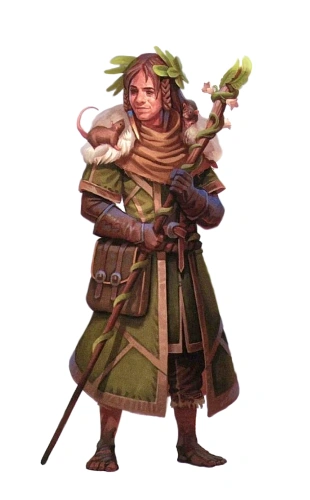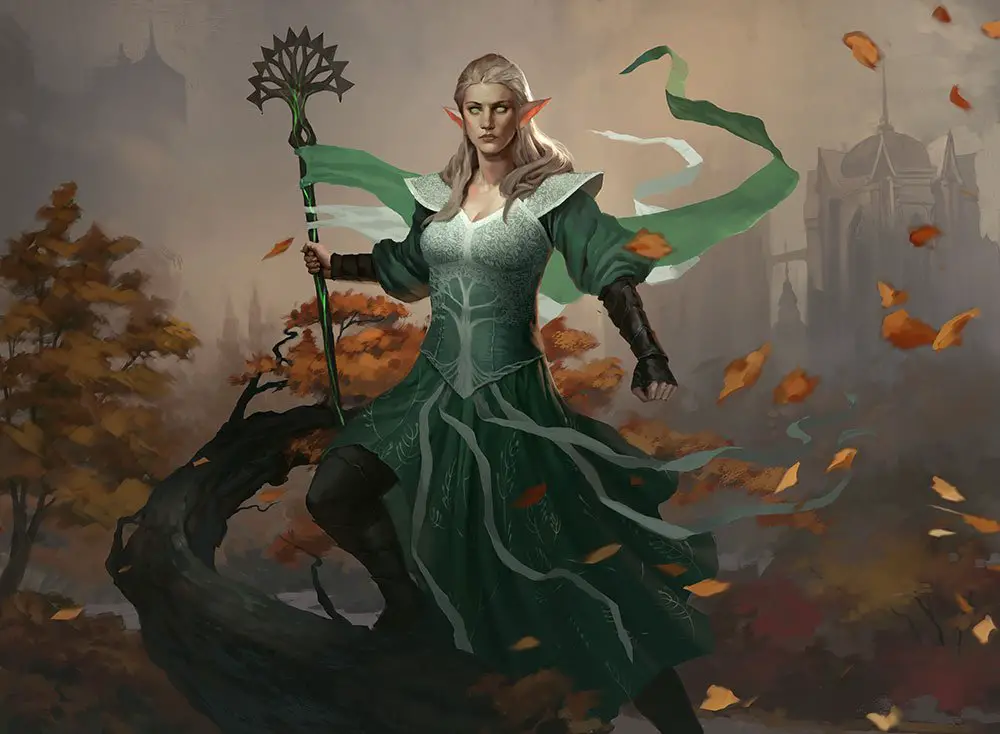Walking the line between reality and the realm of dreams, Druids of the Circle of Dreams offer joy and rest to weary hearts. After all, even the most mighty warrior needs time to rest and recover!
Ahh…
To sleep… perchance to dream…
So grab a nice cup of tea, curl up by the fire, and take a load off.
This is the full guide to the Circle of Dreams Druid in D&D 5e!
What is the Circle of Dreams Druid?
Druids of the Circle of Dreams are tied strongly to Feywild the dreamlike realms within it.
While many Druids are notoriously standoffish and prefer their privacy, Dreams Druids are often compassionate and warm-hearted folks. Aligning well with good creatures of the Feywild, the Circle of Dreams Druid adds a sense of wonder to the lands that they protect.
Calling upon the healing powers of nature, these Druids serve to mend the hearts, bodies, and souls of those that they encounter.
Embracing the power of dreams, Druids who walk this path bring a sense of comfort and peace with them wherever they go.
Of course, they also bring a healthy dose of signature fey trickery and mobility to the table as well! After all, things in the realm of dreams may not always be exactly as they seem…
The Circle of Dreams Druid was introduced in Xanathar’s Guide to Everything alongside the Circle of the Shepherd Druid.
Role in the Party
The Circle of Dreams Druid keeps with the Druid class’s general theme of adaptability.
Unlike other Druid subclass options like the Circle of Spores, Dream Druids are not likely to be on the front lines of the party in battle.
However, that doesn’t mean that they’ll be hanging around in the backline either! Keeping at mid-range allows the Circle of Dreams Druid to position themselves wherever they are most helpful.
The Circle of Dreams Druid makes for a fantastic healer thanks to their Balm of the Summer Court ability. Being able to heal a creature within 120 feet of you as a bonus action is ridiculously useful.
Furthermore, since this is an ability, you are still free to cast a spell with your action if you so choose!
As the Dreams Druid levels up, their abilities begin to show some of the trickier sides of their fey nature. Protecting the party while they rest, using secret fey passages to teleport around a battlefield and more means that the Circle of Dreams Druid is difficult to pin down.
Personally, being able to use spell slots for some of the bigger Druid spells without sacrificing the ability to heal is a major plus. Even better is being able to heal and cast those spells on the same turn.
Now THAT’s what I call an efficient action economy!

Circle of Dreams Druid Features
So we lightly touched on the Circle of Dreams Druid’s abilities when talking about their role in the party, but let’s really dig in now!
This subclass’s abilities do a wonderful job of highlighting these Druids’ fey nature. With some cleverness and creativity, mechanics and flavor combine to create something truly incredible with this subclass!
Balm of the Summer Court (Level 2)
Every class or subclass has a “bread and butter” ability that just defines it. Without fail, they will always be using it nonstop.
For the Circle of Dreams Druid, that ability is the Balm of the Summer Court.
And boy is it a treat!
You have a pool of fey energy represented by a number of d6s equal to your Druid level.
As a bonus action, choose one creature you can see within 120 feet of you and spend a number of those dice equal to half your Druid level or less.
Roll the spent dice and add them together. The target regains a number of hit points equal to the total. The target also gains 1 temporary hit point per die spent.
You regain all expended dice when you finish a long rest.
We kick things off by gaining a new resource in the form of a pool of d6s.
Positioning themselves as a mid-line combatant, the Circle of Dreams Druid can likely heal any of their allies on the map. This is particularly useful if you have a party member who drops to 0 hit points more than 60ft (or whatever your maximum movement happens to be) away!
This is a reliable way to keep your party members on their feet in combat without having to compromise your own positioning.
Of course, being able to also sprinkle some extra temporary hit points on top of this healing is helpful as well! For each die you spend with this feature, that’s one extra point of protection for your target!
As with any resource, make sure that you’re using your judgment when you use these dice. If you burn through them too quickly, you won’t have any more until the next adventuring day!
Using Balm of the Summer Court and Wildshape
Ok, so it’s not like a Circle of Dreams is going to be out-healing a Life Cleric, though I suppose few can. Either way, the utility you gain with this is still just so freaking amazing.
Nothing shows this off better than using Balm of the Summer Court while using your Wild Shape.
Remember: Balm of the Summer Court is not a spell and is simply an ability!
When using Wild Shape, the Player’s Handbook explicitly states that “you retain any features from your class, race, or other source and can use them if the new form is physically capable of doing so.”
Combining this with the Balm’s huge range, you can function as a secret helper if the situation requires it. Inconspicuously flying overhead and dropping some emergency heals on an ally is a very fun tactic.
Similarly, if you need to Wild Shape into a bear to help your party’s frontline, being able to still provide healing while pumping out front-line damage is very powerful!
Related: The Ultimate Guide to Wild Shape in D&D 5e!

Hearth of Moonlight and Shadow (Level 6)
At 6th level, the Circle of Dreams Druid gets the Hearth of Moonlight and Shadow feature.
This is a cool ability that is certainly far from useless, but I have to be honest… It is admittedly a little underwhelming and pretty situational.
During a short or long rest, you can invoke the shadowy power of the Gloaming Court to help guard your respite.
At the start of the rest, you touch a point in space, and an invisible, 30-foot-radius sphere of magic appears, centered on that point. Total cover blocks the sphere.
While within the sphere, you and your allies gain a +5 bonus to Dexterity (Stealth) and Wisdom (Perception) checks, and any light from open flames in the sphere (a campfire, torches, or the like) isn’t visible outside it.
The sphere vanishes at the end of the rest or when you leave the sphere.
It is important to note that Hearth of Moonlight and Shadow does not provide cover, but it is blocked by total cover. This means that you want to make sure that everyone is in an otherwise open space when using this ability.
But here’s the thing… I’m slow to call any spell or ability in D&D useless, but this is definitely a situational feature.
As I wrote when discussing True Strike, there are always situations where certain effects can suddenly become unexpectedly useful! Hearth of Moonlight and Shadow is exactly this kind of feature.
When I played a Circle of Dreams Druid, we did not have any real moments where this ability could shine.
When resting, our Wizard was always able to cast Tiny Hut so that we could rest safely in the dungeon. Because the Hut gave protection that Hearth of Moonlight and Shadow didn’t, there wasn’t a real need to use this ability.
In Defense of Hearth of Moonlight and Shadow
But there are some situations in which Hearth of Moonlight and Shadow is a fantastic thing to have.
Keep in mind, a +5 bonus to Stealth and Perception is absolutely nothing to turn your nose at!
Whoever is keeping watch during the rest will have a much better time for it! They’ll have the benefit of a hidden campfire for light plus the bonus to their Perception!
Going from rolling at disadvantage to rolling at a +5 is a pretty big jump!
Remember that taking a rest is not just plopping down somewhere and going to sleep. You need fire, food, drink, and a bedroll. Hearth of Moonlight and Shadow prevents your fire from attracting curious creatures or enemies.
So, in general, spells like Tiny Hut that provide shelter are probably going to be more useful than this feature. However, that doesn’t mean that you may not have situations where this can really shine!
All in all, it’s my only real complaint about the Circle of Dreams Druid. But you win some, you lose some, right?

Hidden Paths (Level 10)
Speaking of winning some and losing some, Hidden Paths is a definite “win” of a feature!
Whether you’re trying to reposition, come to an ally’s aid, or get out of an enemy’s grapple, you’ll always be able to find a secret fey passageway to your destination!
As a bonus action on your turn, you can teleport up to 60 feet to an unoccupied space you can see. Alternatively, you can use your action to teleport one willing creature you touch up to 30 feet to an unoccupied space you can see.
You can use this feature a number of times equal to your Wisdom modifier (minimum of once), and you regain all expended uses of it when you finish a long rest.
This ability is like Misty Step on steroids and, like Balm of the Summer Court, only takes a bonus action! Even better, you can still use a spell for your action since this is a class feature.
This is a powerful “get out of trouble” ability and it works wonderfully as a type of “panic button” if things get bad. However, it can also be used to quickly close the distance to heal a wounded ally, stop a fleeing enemy, or navigate a perilous obstacle.
Though we can’t forget that this also gives you the ability to teleport other (willing) creatures as well.
This is perfect for helping an ally that’s in danger or for getting around certain challenges and obstacles. For example, it can be used to position your heavily-armored Paladin for an ambush without requiring them to make a difficult stealth check at disadvantage!
Because you can use this ability a number of times equal to your Wisdom modifier, you’ll be able to get some solid mileage out of this between long rests.
Realistically, by level 10, your Wisdom should be 18 or 20 which means that you’ll be able to use this 4 or 5 times per day.
Not too shabby at all!
Also Check Out: The Best Druid Spells By Level in D&D 5e!
Walker in Dreams (Level 14)
The Circle of Dreams Druid’s level 14 capstone feature is definitely an interesting one. You’ll be gaining several unique utility options that stem from your ability to travel mentally and physically through dreamlands.
When you finish a short rest, you can cast one of the following spells without expending a spell slot or requiring material components: Dream (with you as the messenger), Scrying, or Teleportation Circle.
Once you use this feature, you can’t use it again until you finish a long rest.
Your first option is the Dream spell with yourself as the messenger. This can be used for relaying information back to specific people or for some more mischievous ends if used on an enemy.
If you’d prefer a bit of eavesdropping, you may choose to use Walker in Dreams to cast the Scrying spell. If the party is moving ahead and wants to spy on the Boss, this can give them some very useful intel.
Alternatively, you may want to use this Scrying to check back on friends, family, or a specific location. It’s a free Scry, so why not?
Lastly, the Druid’s Walker in Dreams ability gives them a special use of Teleportation Circle.
However, this use of Teleportation Circle is also a little different than the normal spell…
Rather than opening a portal to a permanent teleportation circle, it opens a portal to the last location where you finished a long rest on your current plane of existence.
If you haven’t taken a long rest on your current plane, the spell fails but isn’t wasted.
This can greatly speed up the party’s travel and is an inexpensive way to get back to safety as long as you’re on the same plane as wherever you last took a long rest.
While this capstone is a mix of flavor and situational use, it can still add a lot to your character. The ways that you can incorporate this are largely entirely up to your own imagination and can make for both fun and useful moments.

Connections
The Circle of Dreams Druid has one foot in the Feywild and the other in the Prime Material plane.
When looking to connect a Druid of this subclass into your game, consider how this impacts their personality, background, and goals.
How did they come to discover a location’s ties to the Feywild? Were they mentored by a friendly Dryad or did they perhaps find themselves partying with a group of Satyrs?
What if, as a child, the character grew up playing with Pixies near their village only to later be introduced to the Feywild itself?
There’s no shortage of ways that a character could find themselves connected with the Feywild through fortune or fate. After all, the Fey are notorious for working in mysterious ways!
For a Circle of Dreams Druid, this connection will play a major part in roleplaying your character.
Within the party, a Dreams Druid is likely to be a gentle and comforting presence with the important role of supporting their allies.
Walking the line between the Feywild and Material Plane, they likely have unique insights and perceptions that allow them to function well as a kind of “voice of reason” within the group.
Is the Circle of Dreams Druid Good?
So, is the Circle of Dreams Druid actually good and worth playing?
It’s certainly a unique subclass, and two of your four features (Hearth of Moonlight and Shadow and Walker in Dreams) tend to be more situational than anything.
But if your playstyle falls within the realm of healing and utility support, you will likely enjoy the Circle of Dreams Druid.
The real trick to getting the most out of this subclass is in recognizing situations and knowing how to use your spells and features to best support your allies.
Mixing in the Druid’s utility and adaptability with the ability to drop heals with Balm of the Summer Court and blink around the map with Hidden Paths is crazy useful.
If you stay adaptable (which Druids tend to be good at), you should be able to make a strong impact.
I can’t say that this is the best Druid subclass (at least mechanically), but it is my personal favorite. Then again, I have a huge weakness for anything involving Fey themes.
But even mechanically, the clever uses of your bonus action with Hidden Paths and Balm of the Summer Court make for some excellent action economy.
Related: Ranking Every Druid Subclass in D&D 5e!
Conclusion – Circle of Dreams Druid in D&D 5e
In many discussions, this subclass seems to be commonly overlooked and underrated. To be honest, I had largely overlooked it as well for quite some time until I decided to give it a try for myself.
But playing a Circle of Dreams Druid was one of the most fun experiences I’ve had in D&D 5e. There is so much opportunity for the Feywild to creep into the story through this class that can add even more wonder to any game.
It might be a bit more linear than most of the other Druid subclass options, but that’s hardly a bad thing. The Circle of Dreams Druid delivers some great value to any party that they join.
And speaking of delivering some great value…
Don’t forget to check out my Complete Druid Guide for D&D 5e! It covers everything you need to fully channel the power of nature on your adventures!
Got questions about the Circle of Dreams Druid or want to share your thoughts on this unique subclass? Let’s chat in the comments below!









